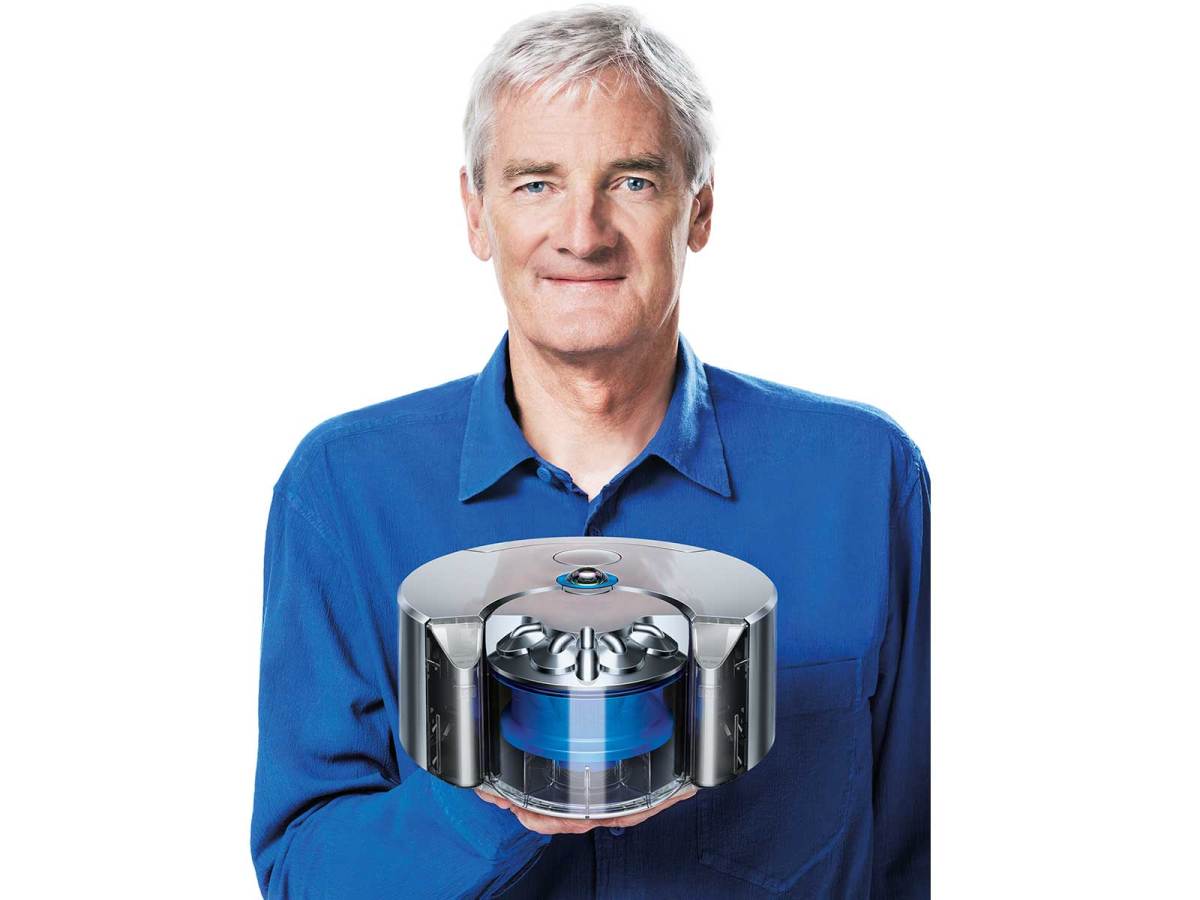Dyson has officially entered the robot vacuum market, boasting to have manufactured a robot that cleans properly, ‘sees’ its surroundings and has the most powerful suction of any existing robot vacuum.
Possibly the company’s worst kept secret — that Dyson have been working on a robot vacuum — was confirmed today when the Dyson 360 Eye robot vacuum cleaner was unveiled in Tokyo. It will go on sale in Japan in the Northern Hemisphere’s spring 2015, with the rest of the world to follow later in the year.
The Dyson 360 Eye is the result of 16 years of research and development and is being hyped as the company’s biggest floorcare innovation since the UK launch of its first vacuum cleaner the DC01, 21 years ago.
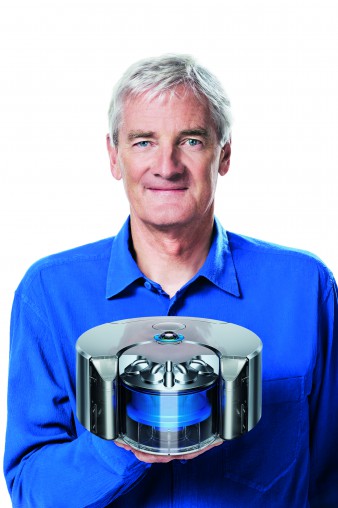
In the past Sir James Dyson dismissed the existing models of robot vacuums in the market and said Dyson wouldn’t be entering the category until it had a machine that could clean ‘properly’.
While Dyson’s opinion of its now-competitors’ robots hasn’t changed, it is confident it has a product capable of living up to the Dyson reputation.
“Most robotic vacuum cleaners don’t see their environment, have little suction, and don’t clean properly. They are gimmicks,” Sir James Dyson said.
“We’ve been developing a unique 360 degree vision system that lets our robot see where it is, where it has been, and where it is yet to clean. Vision, combined with our high speed digital motor and cyclone technology, is the key to achieving a high performing robot vacuum – a genuine labour saving device.”
The brand pointed out the features that it believes set its robot apart from competitors.
V2 Dyson digital motor
In an effort to conserve battery power, many vacuum models sacrifice suction by using inefficient motors.
The Dyson Eye 360 is powered by a V2 Dyson digital motor and uses Radial Root Cyclone technology “to effectively separate dust and dirt, capturing particles down to 0.5 microns – 600 times smaller than the dot at the end of this sentence.”
A 360 degree vision system
When delegating cleaning responsibilities to a robot they are prone to miss spots. Brands have been working to overcome these blind spots with sensors and cameras. But Dyson’s model, as the name suggests, has a 360 degree vision system which it uses to build up a detailed floor plan of a room and vacuum accordingly.
Dyson’s in-house team of 31 robotic software engineers put in over 100,000 hours to create the robot’s navigation system.
“Infrared sensors work in conjunction with a lens on the top of the machine that houses a 360 degree panoramic camera. The camera can see all the room at once so the machine can accurately triangulate its position. It then uses landmarks within the images to establish how it has moved between each frame and update its model of the environment accordingly,” the company said in a statement.
It’s not just what the Dyson 360 Eye has which sets it apart from competitors, but also what it doesn’t have.
No wheels
The wheels have come off and been replaced with continuous tank tracks, making the Dyson 360 Eye part-all terrain vehicle. The tank tracks allow it to maintain speed and direction across all floor types, and over small obstacles.
Say goodbye to sweepers
Other robot vacuums rely on side sweepers to extend their cleaning reach and brush dirt from the edges of the room underneath the robot vacuum. The brush bar on the Dyson 360 Eye vacuum cleaner extends to the full width of the machine, meaning that it doesn’t rely on side sweepers. “It uses patented carbon fibre brush bar technology to remove fine dust on hard floors, and stiff nylon bristles to agitate and clean carpets.”
There’s an app for that
The appeal of a robot vacuum is not just hands free cleaning but also being able to automate the process remotely. Dyson has a new app, the Dyson Link App for iOS and Android that lets owners schedule when the machine cleans from their smartphone.
Robovac versus Robovac
Battery life and bin capacity are two areas where we can compare the specs of the Dyson 360 Eye with its competitors. The Dyson 360 Eye holds up to 0.4 litres of dust and dirt and weighs 2.37 kilograms.
Dyson says the lithium ion battery delivers a 20-30 minute run time with no drop in performance and when power is running low it will return itself to the docking station to recharge.
Miele unveiled its first robot vacuum earlier this year, the Scout RX1. The manufacture of the machine has been outsourced to a Korean robotics company, but is still being overseen by the German brand.
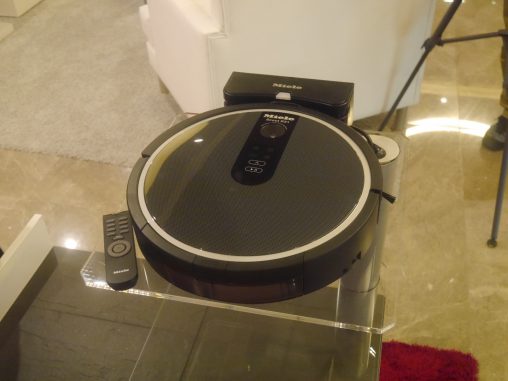
The Scout RX1 has a two hour run time— four times that of Dyson’s — and is slightly heavier at 2.9 kilograms. It also has a smart navigation system featuring a gyro sensor that measures and registers the turning movements with the high-quality digital camera scanning the ceiling of the room several times a minute to ensure complete cleaning.
“The Scout RX1 also benefits from seven infra-red sensors that scan 180 degree in front of the robovac to avoid collisions with a further three sensors beneath the unit to avoid falling off steps,” Miele says on its website.
Miele also says it has got a model that can clean effectively thanks to its Triple Cleaning System. Two long rotating side brushes (a feature Dyson dismisses as “merely flicking particles around”) sweep dirt towards to centre of the unit to be picked up by a removable beater, and in the third stage, a fan transports the finer dust into a dust box.
The removable dust container has a capacity of 0.6 litres, marginally bigger than Dyson’s and, Scout RX1 has a timer and four programmed cleaning modes, but no app.
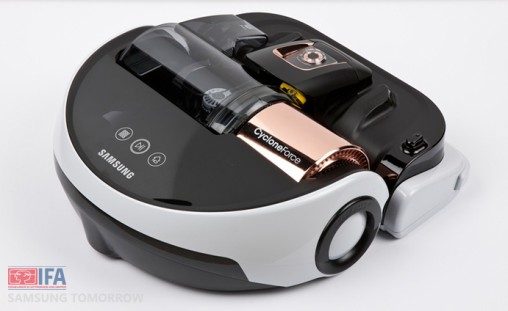
Samsung also announced a new robot vacuum cleaner at IFA, the Powerbot VR9000 which has a feature set focused on improved cleaning performance.
The Powerbot VR9000 uses Samsung’s smart Digital Inverter Technology (the same that can be found in Samsung refrigerators) to create suction power up to 60 times more powerful than the Samsung conventional robot vacuum (VR10F71UCAC).
A wider brush runs along the base of the unit and the side sweeping brushes have been removed. It uses CycloneForce technology, which the brand said “generates a strong centrifugal force that circulates dust particles through the inner chamber so the dirt and debris is separated from the air and sieved into the outer chamber.”
The sleek design also addresses the vision issue with the inclusion of a FullView Sensor that helps it to understand its surroundings. A suite of sensors helps the Powerbot to locate very narrow or small obstacles across a wide area while minimizing “blind spots.”
In addition, large Easy Pass wheels on the wings of the Powerbot VR9000 and the raised body, up to 15 millimetres, enable the machine to overcome hurdles like wires or door frames.
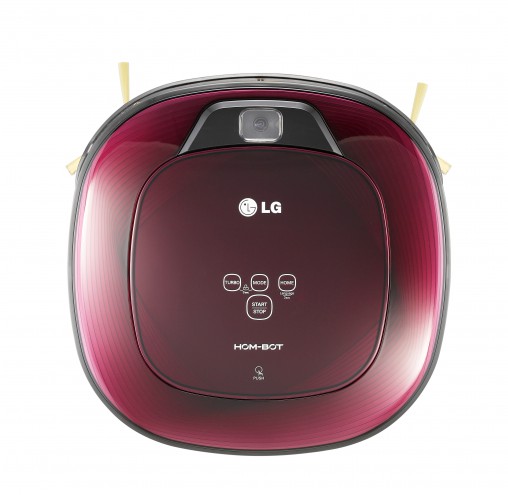
LG’s Roboking Square vacuum cleaner comes with dual eye sensors camera sensors to scan and map floor surfaces. It also has a learning function that remembers areas it has previously cleaned.
The Roboking Square boasts a run time of up to 100 minutes off a three hour charge and cleans quietly at 60 decibels.

